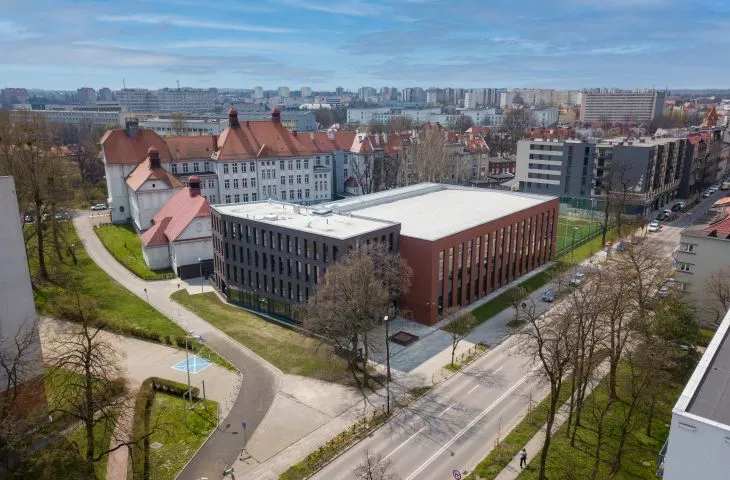A new teaching building and sports hall for the E. Dembowski First Bilingual High School in Gliwice has been built. The school's modern, simple form is the work of architects from the Cracow studio ARP Manecki. The clinker brick used on the facade refers to the characteristic buildings of Silesia.
The new school consists of a teaching area and a sports area. These two functions have been emphasized in both the form and color scheme of the building. The didactic part is marked by a facade of dark clinker brick, while the light brick is the sports segment.
The teaching part is marked by a dark facade
Photo: Piotr Król © A R P Manecki
We wanted to integrate the building into the existing urban fabric and match it with the already existing historic school building. The lump of the teaching segment, through a characteristic "break", continues the building line of the school building. On the first floor, the fully glazed body, has been overhung over the entrance from two sides - from the street and from the school courtyard, explains architect Mateusz Manecki, author of the project.
The rhythmic division of windows and the manner of finishing also creates a direct continuation of the architecture represented by the building of the neighboring Silesian University of Technology.
teaching part
The teaching part consists of three floors. Each of them has a lecture hall that can accommodate 32 students and two experimental rooms, prepared for 16 students. The workshop rooms have a sliding wall that allows them to be connected. On the second floor, classrooms are provided for biology, the second floor has been designated for physics classes, while on the third floor, classrooms for chemistry await students. Each teaching room will be equipped with an experimental table so that the teacher can conduct demonstration experiments.
The building is characterized by rhythmic window divisions
Photo: Piotr Król © A R P Manecki
Our students are the best at passing the matriculation exam in physics in the whole country. We are one of two public schools in the Silesian province that provide the opportunity to pass the International Baccalaureate. That's why we were so keen to provide students with the best possible conditions for acquiring knowledge. The existing school building was built in 1915 and did not meet current requirements," says Adam Sarkowicz, the school's director.
sports part
The architects designed a full-size sports hall
© A R P Manecki
The historic building had a sports hall that was too small. In the new building, the architects designed a full -size handball hall with the possibility of dividing it into three smaller sections. The surrounding stands can accommodate 150 people. The building also includes sanitary facilities and locker rooms, and above them space has been set aside for a gym. The facility has been thought out so that it is possible to use the sports section also when the school is closed.
The sports section is marked by bright brick
Photo: Piotr Król © A R P Manecki
Dobrawa Bies: You had to fit the new school facility into the existing school building, as well as into the urban fabric of the city. Was this quite a challenge? How did the design work and construction proceed?
Bartosz Falkowski: We tried to fit the new building into the existing urban fabric, the lines defining the shape of the block are a result of the course of the street and the urban layout of the existing school (location in the corner of the plot on the street leading to the city center), hence the break in the cuboid shape of the educational segment. By moving the entrance part back from the building line and abandoning the fence (the building is a fence), a micro urban square was created, which provides a foreground for the commercial entrance and distinguishes the object in the street frontage.
The school grounds included space for two outdoor playing fields
Photo: Piotr Król © A R P Manecki
At the beginning of the design work, we found a concept made for the tender, which assumed the entire facility located on the street side. By optimizing the area and making maximum use of the depth of the plot, we managed to develop the space in such a way that there was room for two outdoor playing fields, along with independent parking spaces. Both the design work and construction proceeded in a very good atmosphere, the special commitment and good cooperation of the school's director Adam Sarkowicz, who acted on behalf of the investor - the City of Gliwice, should be emphasized.
The lines defining the shape of the block result from the course of the street and the urban layout of the existing school
Photo: Piotr Król © A R P Manecki
Dobrawa: What requirements did the investor set before you? What in particular should be taken into account when working on this type of building?
Bartosz Falkowski: The investor required the creation of a prestigious facility to match the results achieved by the institution on the national arena - Gliwice's I LO, for many years, has achieved high rankings. Well-equipped thematic laboratories, with the possibility to conduct experiments and workshops, as well as a full-size sports hall located in the vicinity of the Gliwice University of Technology, on the main street in the old part of the city, were a challenge that we tried to meet. The design of this type of facility is characterized by versatility - adaptation to various possibilities of use by different users, from school classes to outdoor events.































































